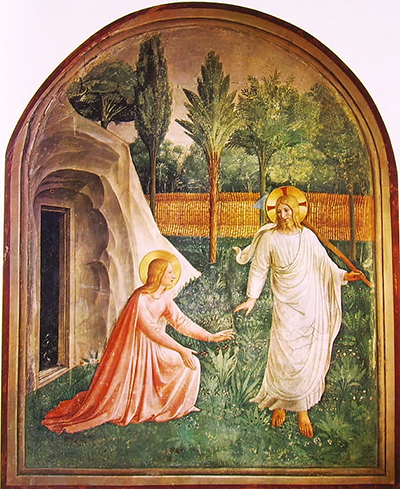Noli me Tangere is one painting in a group of paintings by Fra Angelico that means 'Touch me not.' These paintings depict Christ's life with this one showing life after his rising. At the time of the painting, the Dominican painter was living in San Marco convent in Florence.
Here, he painted the images in forty-four cells and two corridors. This convent is now a state museum. It is believed that the paintings were done using a special coherence and knowledge using codes that cannot be deciphered today. All the details in the image were put in place so that everything remains in place. The flowers were arranged in a pattern on the lawn in the painting. They had two shades of colour, but the lively red colour was at the top and was the most evident. This created few reliefs and improved the rhythm of the image.
The arrangement of the flowers was similar to the way Fa had painted the stigmata (the nail wound marks) on Jesus' foot that was on the grass. Flowers were painted in groups of five like the stigmata. One historian called Didi-Huberman defined this as shift of the iconic sign. It was concluded that the painted saw stigmata as flowers on the body of Christ. Christ then sowed these stigmata in the earthly world. It is said that he believed that after the blood of Christ soaked the earth, it made new humanity to grow. The new humanity imitated Christ as it was redeemed from sin.
Many historians believe that this image was inspired by a greater light than the Fresco technique that Fa used. Some, like the American artist called Mark Rothko, have come up with a chalk mixture that would come close to the fresco-like quality. All the paintings done in the cells connect to each other. They tell a story of Christ from birth to after resurrection. It is believed that the first flowering was that of the conception in the womb of the Virgin Mary and the last flowering was this that is depicted in the Noli me Tangere. Therefore, it presents two parts of Christ's redemption of the world, the birth and the death. Next to the flowers is Mary Magdalene, one of the disciples converted through this conversion.
Angelico was believed to have been inspired by averse in the bible in Isaiah 11:1 that talks of a rod that will come out of the house of Jesse, wither and then blossom after the resurrection. His style of painting inspired countless artists including Mark Rothko and many modern artists. His work is high revered among top artists and historians around the world for its ingenuity and a unique way of telling his story.




